The Morning Glory is often the first flowering vine gardeners become familiar with. Brightly colored trumpet-shaped Morning Glory flowers have a slight fragrance and are popular among butterflies and hummingbirds. The buds are tightly twirled up and open when the sun touches them in the morning. You can start Morning Glory by sowing seeds.
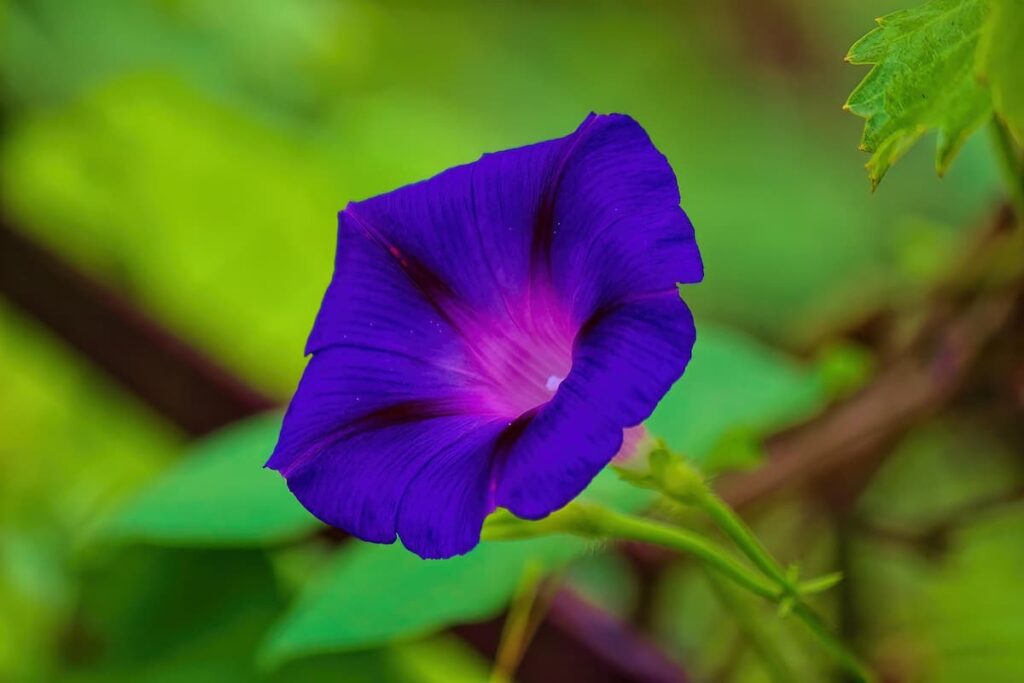
However, you must be aware of sunlight, water, fertilizers, potting mixtures, etc. Like us, plants also need favorable conditions to grow. Morning Glory is a fast-growing vine that produces large, fragrant flowers. They will tolerate almost any soil once established. Heart-shaped leaves reach up to 15 feet long on fast-growing stems. Flowers, in shades of white to purple, begin to form mid-summer and continue until the frost. Large, colorful flowers attract butterflies and hummingbirds.
Growing Morning Glory flowers
Types of Morning Glory
Common Morning Glory
This is probably the most famous type of Morning Glory. It can be 10 feet long. Its flowers are purple, and its throat is white.
Moonflower
This variety is slightly different in that the white flowers bloom in the evening and close before noon the next day. They usually reach a height of 10 to 15 feet.
Cardinal climber
These flower vines produce bright red flowers and are a favorite for hummingbirds.
In case you missed it: When to Apply Organic Pesticides in Your Garden: Best Time, Safety Tips, and Precautions for Beginners
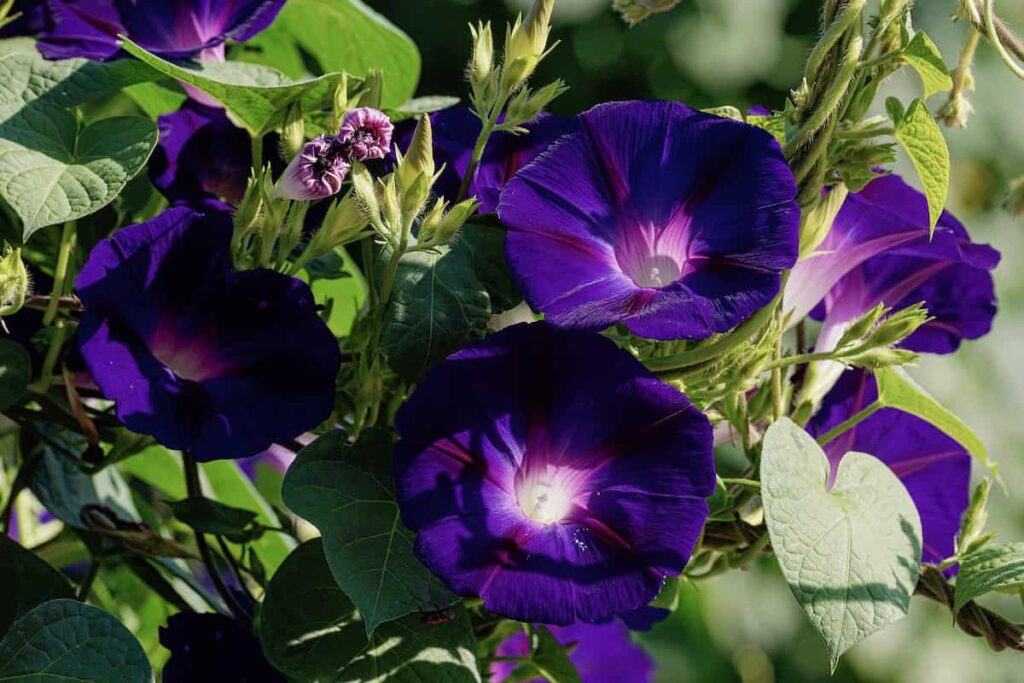
Heavenly blue
This cultivar has flowers in baby blue with purple streaks. They are up to 12 feet long.
Flying Saucer
This cultivar also grows up to 12 feet and includes silver-white flowers streaked with blue. Grow this variety in full sun or partial shade.
Beach Morning Glory
This type offers light pink blooms with dark pink lines and a white center. The plant spreads up to 3 to 4 feet.
Early call
It blooms in a mix of colors, including white, blue, lavender, and pink. Some flowers have white edges.
Climate suitable for growing Morning Glory
Planting your Morning Glory in a place that receives the full sun is especially important. Morning Glory flowers will only bloom when they are in direct sunlight. Make sure to keep the direction of the plant towards sunlight. Sunlight helps in improving the growth of plants. The Morning Glow easily tolerates both cold and hot temperatures. They have grown annually in areas where temperatures drop below 8°C and can be perennial in tropical and subtropical climates. They don’t have any special need for moisture.
In case you missed it: How to Grow Sarpagandha for Beginners: Guide and Steps to Propagation, Planting, and Care
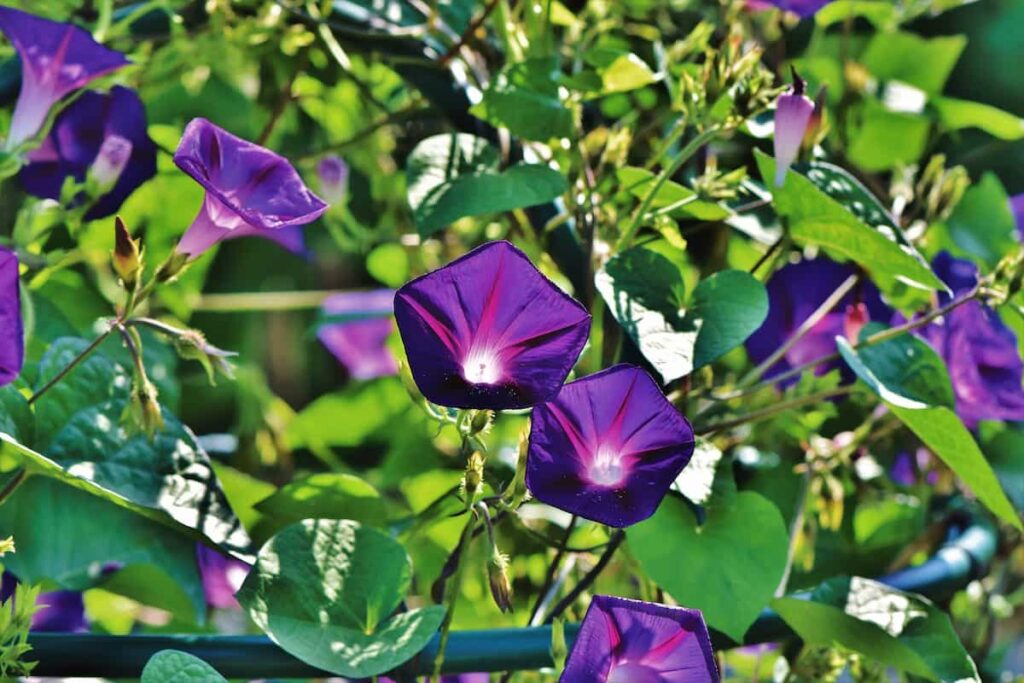
Soil requirement for growing Morning Glory
- The Morning Glory works best in moist soil but drains well. However, they bloom better in soil that is not much richer in organic matter. You can modify the soil later if the vines look like they’re struggling. Prepare the soil before you plant the Morning Glory. These plants do well almost anywhere and appreciate neutral soil pH.
- Use a spade or tiller to loosen the soil, which will help the roots spread to the ground. If your garden has poor drainage due to clay or compact dirt, consider adding organic matter, such as pine bark mulch, to improve your flowering conditions. The Morning Glory plant loves loamy, well-drained organic matter-rich sandy loam soil. So, you don’t have to worry about potting mixes if you already have sandy loam soil in the garden.
- If you have heavy or clay soil, you must prepare an excellent potting mixture for better plant growth. Prepare 40% garden soil, 20% river sand, and 40% organic compost. But if you have sandy loam soil, add organic compost to the soil.
Water requirement for growing Morning Glory
Provide your Morning Glory with regular water, about an inch per week, and mulch around the roots to maintain moisture. The biggest moisture requirements come during the growing period of the plant. Once established, you can slow down your watering cadence. Moderate water is good for this beautiful flowering plant. You don’t consider fixed frequencies for water because climatic conditions can differ. The best way to water is when you see the soil above drying up. Apply a good amount of water, and take care of the drainage holes. Water logging can cause root rot. And it can damage your plant. This is why you must avoid giving too much water.
In case you missed it: How to Make Compost Tea for Your Garden: Benefits to the Plants and Application Methods
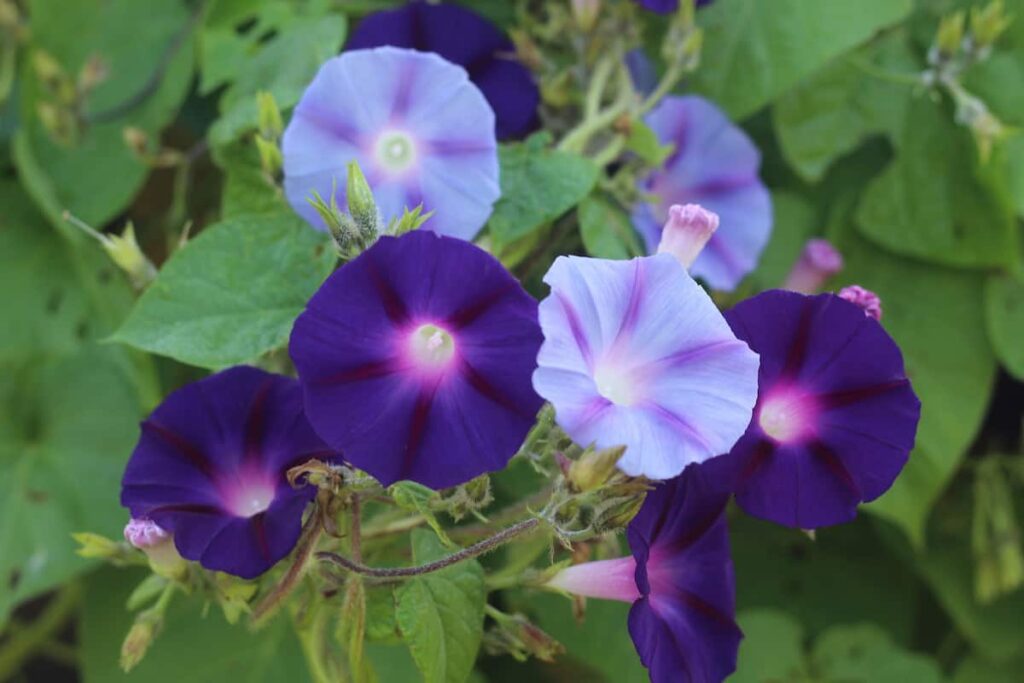
Growing Morning Glory indoors
- Growing Morning Glory directly in the ground can give excellent results. Choose a 10 to 12-inch pot with at least 2 to 4 drainage holes at the bottom if you want to grow in pots. Drainage holes are very important to prevent water from accumulating in the pot. You should select clay or terracotta pots for growing Morning Glory. This helps in ensuring proper air in the root zone of the plant.
- Sow seeds 1 centimeter deep in moist seed compost pots and places them in a hot place, ideally a propagator to grow. Once the plants appear, move to hot well-lit windowsills or greenhouses to grow, supported individually by thin canes as young plants soon begin to climb. You can transplant in individual small pots. You can grow indoors until late May or early June.
Propagation of Morning Glory
You can propagate the Morning Glory either through seeds or cuttings. Seeds allow you to start propagation during the spring season. But it will take around 120 days to produce flowers. Another way to propagate them is by cutting in late summer or the rainy season.
Germinating Morning Glory seeds
- You can improve your Morning Glory germination rate by soaking seeds to break the seed coat. Be sure to soak them in water for at least 24 hours before planting, as this will encourage them to grow a small root. Place your seeds about six inches apart, and once in the ground, cover the seeds with a quarter inch of soil. If you’re growing Morning Glory from seeds, place the seeds in a damp and well-drained pot and cover them with plastic wrap. Secure the plastic wrap around the pot with a rubber band or twine.
- The plastic wrap will trap heat and moisture inside the pot, activating germination. It should take about 7 to 14 days to sprout. Check your seeds every day or two until you see a few sprouts from the soil.
- Once the seeds of your Morning Glory sprout, remove the plastic wrap and move the pot to an area with full sunlight daily. The hardiest plants will survive at this location, while the weakest plants may die due to a lack of moisture or enough light. Place the pot in an area where it can receive bright indirect sunlight. Once the seedlings have 3 to 4 true leaves, you can transplant them into a final position. Prepare fresh potting mixes and transplant them.
Transplanting Morning Glory seedlings
You can directly sow the seeds about 1/4 inch deep, a few inches apart. Or plant three to five Morning Glory plants evenly around a large pot, ideally at least 30 to 40 centimeters wide and deep. Partially fill the pot with a good, peat-free multipurpose potting compost. You should gently remove each plant from its pot. Place the young Morning Glory plants in a large pot, gently filling the gap between the root balls with compost. Then you can water the pot to settle the compost around the roots. If using free-standing support, place it on plants.
In case you missed it: How to Add Nitrogen and Calcium to Your Garden Soil: A Must Guide for Gardeners
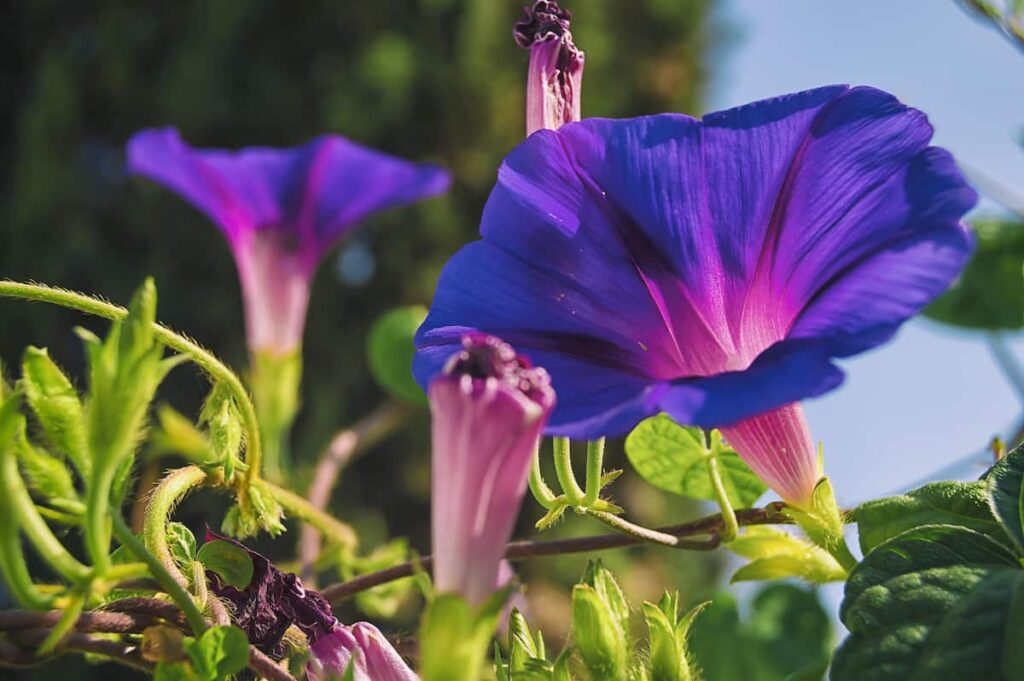
Morning Glory plants care
Fertilizer requirement for growing Morning Glories
- Morning Glory is not a heavy feeder plant. Also, avoid adding too much nitrogen-rich fertilizer. During the early growth stages, you can feed with one to two handfuls of organic compost every 30 days. You can use vermicompost or leaf manure for this purpose. You can use banana or onion peel fertilizer for heavy blooms from summer to autumn. However, avoid adding many types of fertilizer at the same time. Be sure to have a gap of at least 20 to 30 days.
- Feed your Morning Glory with low-nitrogen fertilizer every four to five weeks during their growing period. You can try a mixture of high-phosphorus fertilizers in the case of a lack of blooms. Feeding your Morning Glory is essential, but be careful not to overfeed them. According to the instructions on the label, use a balanced fertilizer and add it in early spring when you plant your Morning Glory flowers. This will give them enough time to absorb nutrients in their growing season without damaging the roots.
Trellis for Morning Glory
- Morning Glory is easy enough to take care of because they are very little care. Make sure you have your trellis to help them progress. Once your Morning Glory vines get this support, they’ll learn to grow it. They will easily grow into the ground if they have nothing to climb.
- When taking care of your Morning Glory, remember that they are climbing vines. Although they will grow along the ground for short distances, this makes them more prone to pests and diseases and usually leads to younger ages. However, you don’t necessarily need some fence to climb them. Morning Glory doesn’t discriminate when it comes to climbing and will grow on anything they’re close to.
Deadheading for Morning Glory
- Once your Morning Glory begins to flower, you can use pruning shears to cut off dead flowers and stems that look wilt and yellow. Doing so will allow more energy in the plant to produce new flowers instead of dying. The exact timing of your pruning session depends on where you live and what kind of Morning Glory you’re growing. If you live in a cool area, wait until mid-June to prune your flowers.
- Deadheading the heads of flowers will encourage new blooms in the summer months. There’s no need for pruning, but you can cut off the growing tip after it reaches the top of the plant support. It may also encourage new shoots to emerge lower down. Growing Morning Glory can give you impressive annual flowers for relatively long periods and cover support structures immediately during the summer months.
Pest and diseases of Morning Glory and their control
Pests
- Spider mites, usually seen as small red or orange dots, can damage plants, including Morning Glory. Mites are true spiders with web-spinning abilities and live in colonies under the leaves. They damage the Morning Glories by sucking juices from the plants. The presence of webs or filaments is the easiest way to find mites. They can be removed from the garden hose with a strong spray. If this doesn’t work, a targeted application of ready-to-use insecticidal soap will help eliminate mites. Do not apply soap when the temperature is more than 32°C.
- Pests such as cotton aphids, leaf miners, and leaf cutters can also affect Morning Glories. The cotton aphid likes to attack the plant in the morning. These insects’ colors vary from yellow to black; you can find them in public on your leaves. The leaf miner does the same; it bores holes into the leaves. The best way to eliminate your Morning Glory from these insects is by using organic pest control and keeping your plant as healthy and happy as possible.
In case you missed it: How to Choose the Right Soil Testing Meter for Your Garden: Best 20 Soil Testing Meters/Kits in India
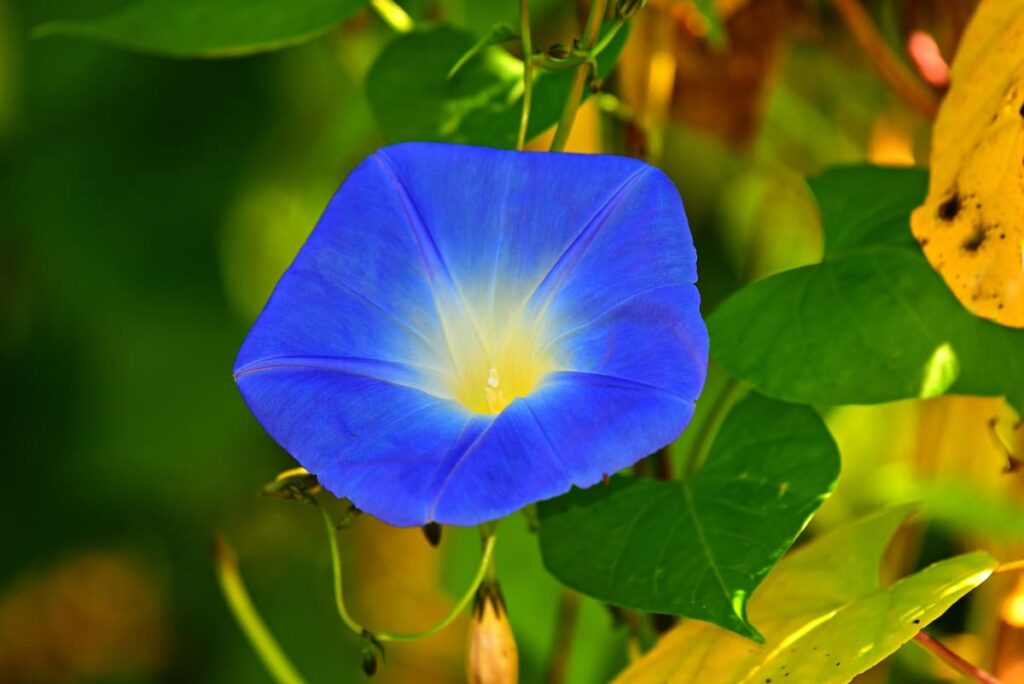
Diseases
Damping-off
Morning Glories and other annuals starting indoors or outdoors from seeds can sometimes suffer from disease-damping off, a fungal problem that causes plant stems to wilt. This can be prevented by starting seedlings in a fresh, sterile potting mix and watering the seed tray from the bottom. Alternatively, the Morning Glory can be sown directly in planting beds that have been solarized and covered with clear plastic for four to six weeks before planting.
Rust
To diagnose whether your plant has rust or not, look closely at the leaves. There will be powdered pustules on the back of the leaf. They are the ones that cause the leaf to turn yellow or even orange. To prevent this, don’t over-water your Morning Glory and remove any infected leaves.
Harvesting Morning Glory seeds
Morning Glory is a popular annual vine growing in different soil conditions and container gardens. Usually, flowers bloom a single morning and die in the afternoon, although on cloudy days, flowers may live well in the evening or early at night. Morning Glory requires very little attention in the garden, and there is no special knowledge in collecting seeds from Morning Glory.
Once the seed pods turn brown and dry, and the leaves peel off, gently crush the pod into your palm. Depending on the size of the pod, each pod will have 2 to 5 seeds. Seeds are relatively good-sized and are very hard when dried, so you don’t have to be too delicate with them.
Conclusion
The Morning Glory adds a beautiful shine to your home with its different shades. They have lovely flowers that bloom throughout the day. The Morning Glory grows easily and requires little care after planting, making them a popular choice among gardeners who do not have time to take care of their plants or want an instant touch to their backyard or patio.
- How to Grow Hibiscus from Flower
- Plantation Ideas for Home Decoration: A Beginners Guide
- Flower Garden Designs and Layouts for Beginners
- Planting and Spacing Techniques in Papaya: A Beginner’s Guide
- Growing Gold: Essential Techniques for Planting Pineapples
- How to Make Kalanchoe Plant Bushy: Home Remedies and Solutions
- 11 Reasons Why Your Gardenia is Not Blooming: Home Remedies and Solutions
- Eco Elegance: The Guide to Designing a Drought-Tolerant Landscape
- Gardening on a Slope: Strategies for Hillside Landscaping
- Nourish and Flourish: Top Organic Mulches for Thriving House Plants
- Everything You Want to Know about Indian Mogra Flower: Discover Uses and Growing
- Green Thumb Success: Expert Tips for Cultivating Greenhouse Pumpkins All Year Round
- Maximize Growth & Flavor: The Ultimate Guide to Companion Planting in Herb Gardens
- How to Control Rhododendron Problems Naturally: Home Remedies and Organic Ways to Fix Them
- Natural Magic: The Remarkable Benefits of Cinnamon for Plants
- Best Steps to Revive Dying Tulip with Natural and Organic Treatment
- 10 Reasons Why Your Angel Trumpet is Not Blooming: Remedies and Treatment
- How to Fix Periwinkle Leaf and Flower-Related Problems: Natural Remedies and Solutions
- How to Fix Zinnias Leaf and Flower Problems: Discover Natural and Home Remedies
- Organic Steps to Induce Lemon Tree Flowers: A Comprehensive Guide
- Bloom Booster: Crafting the Perfect Homemade Bougainvillea Fertilizer
- Optimizing Growth: A Guide to Applying NPK Fertilizer for Potted Plants
- 10 Best Homemade Fertilizers for Rubber Plant: DIY Recipes and Application Method
- How to Boost Female Pumpkin Flowers: Effective Steps for More Flowers and High Yields
- Transform Your Indoor Garden: Top Benefits of Pink Salt for Houseplants
- 10 Best Homemade Fertilizers for Peacock Plants (Calathea): Easy DIY Guide
- Unlock Blooms: 9 Reasons Why Your Potted Chrysanthemum is Not Blooming
- 8 Reasons Why Your Potted Hibiscus is Not Blooming: Fix it with Simple Solutions
- Unlock Blooms: 9 Key Reasons Your Potted Frangipani Won’t Flower
- 10 Reasons Why Is My Ice Plant Not Blooming: Remedies and Treatment
- 10 Reasons Why My Potted Hydrangea Not Blooming: Treatment and Remedies
- 10 Reasons Why is My Wisteria Not Blooming: Remedies and Treatment
- 10 Reasons Why is My Goldfish Plant Not Blooming: Remedies and Treatment
- Maximize Your Space: Ultimate Guide to Balcony Gardening with Grow Bags
- 10 Reasons Why Your Iris is Not Blooming: Remedies and Treatment
- 10 Reasons Why Your Anthurium Plant is Not Blooming: Treatment and Remedies